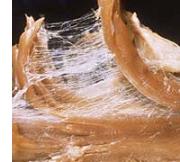|
Myofascial release therapy
Before entering into myofascial release therapy we must first understand the nature of
`fascia'
and of it's importance within our bodies. Fascia is in fact what is commonly known as `connective tissue, and is a body system within itself. It is a tough white stringy membrane composed of tiny fluid filled micro tubules that exists as a continuous and uninterrupted multidimensional matrix support tissue structure that covers every muscle and organ within the entire body, extending from head to toe, back to front and from exterior to interior.

It's purpose is to provide structural support and integrity for posture,locomotion and equilibrium as well as dealing with vital immune system regulation and also acting as a communication conduit within the body. Unlike muscles which relax and contract connective tissue keeps continual tension and is so strong it can exert a force equivalent to 2000 lbs (907.18 kg) per square inch! In a nutshell if all of your connective tissue was removed your body it would just collapse into a useless heap, totally unable to operate at all.
CGI 3D fascia video courtesy of Ivan Duben Intergrated therapiesHow do problems arise? Interlaced through this fine network are microscopic nerve fibres carrying electrical signals to and from the brain. It goes without saying that the combined systems are very finely balanced and any offsetting can lead to problems not just just to one but many regions simultaneously due to the interconnectivity within them. The tension of fascia can however be altered by physical as well as emotional states, and even after an injury of some descript. One big enemy of fascial integrity is dehydration which can possibly cause the tiny micro tubules to contract thus exerting pressure on nearby nerve fibres hence causing pain and discomfort.
The process of myofascial release therapy MFR is a mild form of therapeutic massage with the aim of stretching and balancing. Pressures applied can vary depending on the complexity of the problem. MFR is not an `island' therapy as such more so is a re-education of the body's alignment so therefore other aspects are taken into account such as correct nutrition and sometimes even neurolinguistic re-education is part of the overall therapy treatment. Occasionally it may take two therapists to work on a client although this is not entirely necessary. The therapist works more as a facilitator than an enforcer. Focusing on a mutual trust and creating a calming situation to achieve optimal results. Bare in mind the brain knows via it's own blueprint of the correct positioning of it's own frame therefore the aim is to free the mind of any anxieties so that it can `self correct'.
Profile: Peter Chripczuk Peter specialises in pain management and body structural engineering through MFR (utilising the
John Barnes method)
to deep tissue, remedial and sports massage techniques encompassing these with bowen therapy and thermo therapy.
Contact and or feedback Back through the lens 

|





